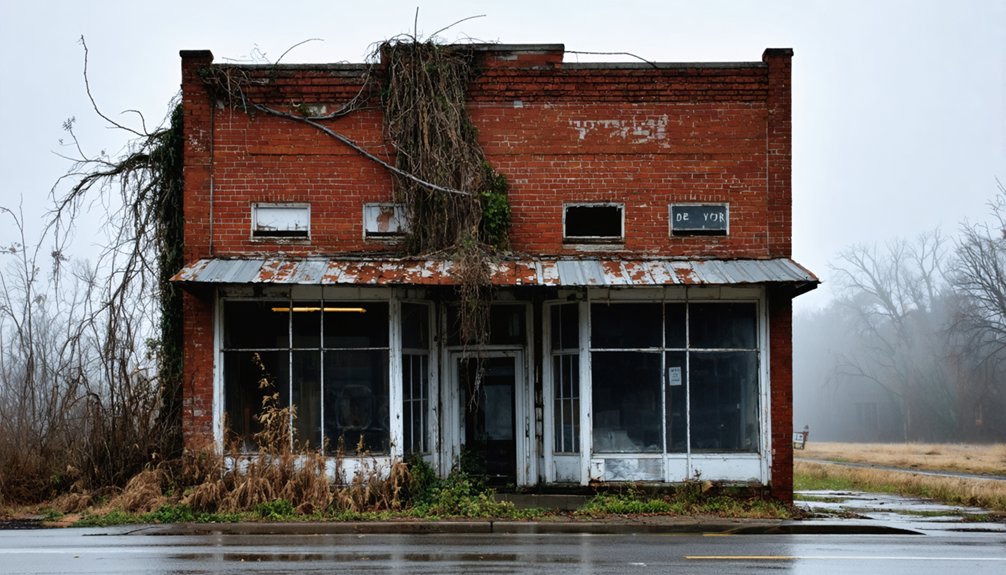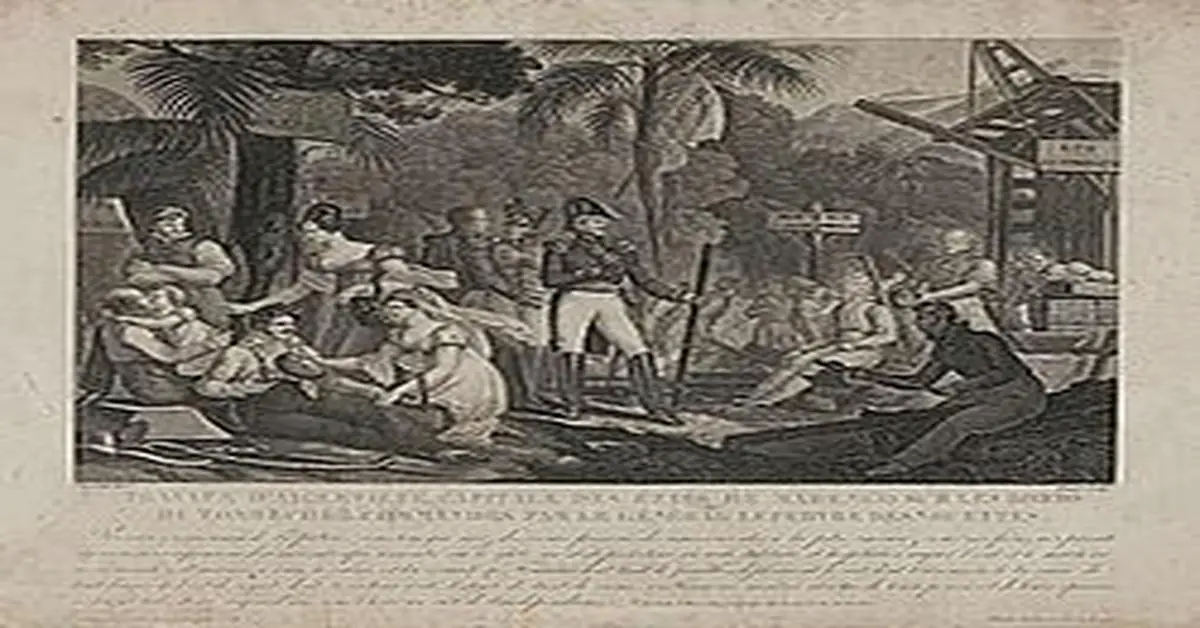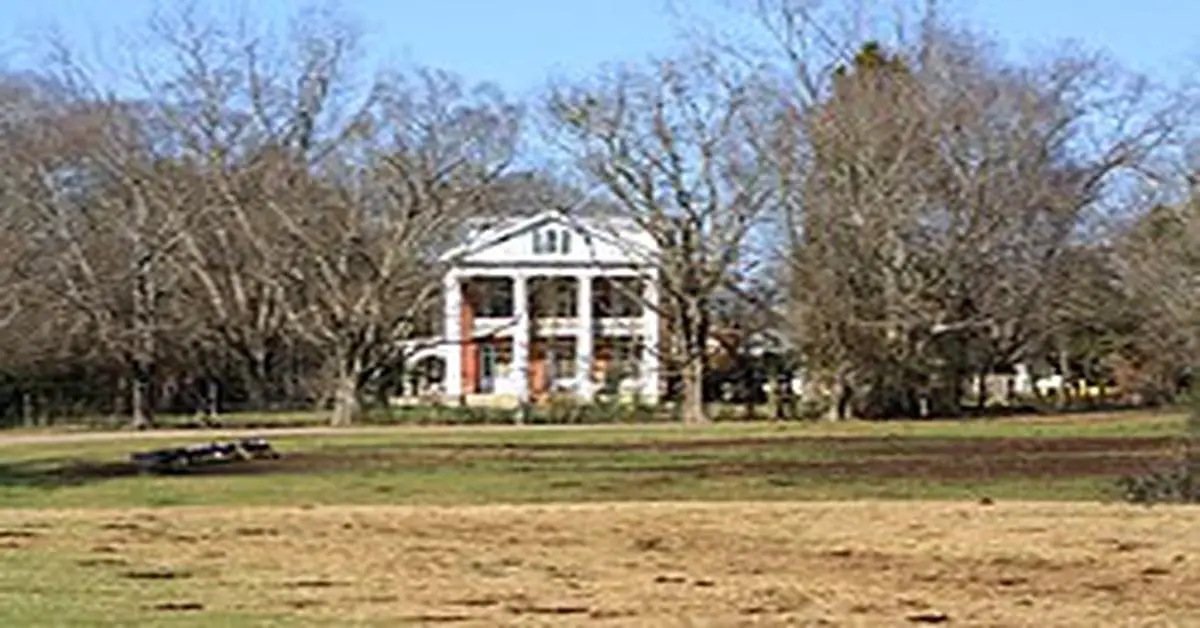You’ll find Battelle’s remnants tucked away in Alabama’s Lookout Mountain, where a bustling iron mining town once thrived from 1902 to 1905. Colonel John Gordon Battelle’s ambitious venture included a blast furnace complex, hundreds of homes, and advanced infrastructure that supported mining families. While nature has reclaimed most structures, you can still spot scattered bricks, non-native flowers, and mysterious coke ovens among the dense forest. Local ghost stories and Cherokee legends add intrigue to this forgotten industrial settlement.
Key Takeaways
- Battelle was a thriving mining town established in 1902 near Lookout Mountain, Alabama, centered around iron ore extraction and processing.
- The Lookout Mountain Iron Company built extensive infrastructure including houses, schools, stores, and advanced iron production facilities.
- The town operated successfully for only three years before closing in 1905 due to competition from superior Birmingham iron deposits.
- After closure, residents abandoned the town, leaving structures to decay while dense forest gradually reclaimed the industrial and residential areas.
- Ghost stories persist around the old furnace site, while archaeological remnants like coke ovens and building foundations remain visible today.
The Birth of an Industrial Dream
When prospectors discovered rich mineral deposits near Lookout Mountain in 1902, they sparked an ambitious industrial vision that would soon become Battelle, Alabama.
You’ll find that this wasn’t just any mineral discovery – they’d struck upon the perfect trifecta of iron ore, coal, and limestone, all within close proximity. These essential ingredients for pig iron production captured the attention of Ohio mining prospects, particularly Colonel John Gordon Battelle.
Driven by industrial ambition, Battelle personally invested in the venture and relocated to Alabama to oversee operations. For clarity in historical records, this location should be properly referenced as Battelle, Alabama to distinguish it from other similarly named places.
Battelle’s hands-on leadership and personal investment demonstrated his unwavering commitment to transforming Alabama’s mineral wealth into industrial success.
The newly formed Lookout Mountain Iron Company aimed to create a self-sufficient operation, modeling their approach after successful Midwestern enterprises. The company quickly established a thriving community complete with hundreds of houses, a school, and various businesses.
Their strategy focused on vertical integration, planning to control every aspect from mining to processing the valuable minerals.
Mining Glory Days
The early 1900s marked Battelle’s peak as a bustling mining settlement, where the rhythmic sounds of picks striking ore echoed through the foothills of Lookout Mountain.
You’d have found a self-sufficient community built around innovative mining techniques that extracted iron ore, coal, and limestone from the rich earth below. The community thrived with hundreds of workers and their families, supported by a robust infrastructure. Colonel John Gordon Battelle established this industrial haven at the turn of the century. Lookout Mountain Iron Company spearheaded the town’s development and mining operations.
The heart of Battelle’s community dynamics centered around:
- A vertically integrated operation featuring coke ovens and a furnace for pig iron production
- Essential amenities including a school, hotel, and commissary that kept miners close to work
- A sophisticated water system powered by mountain springs, delivering fresh water to every home
Life in a Company Town
Life in Battelle revolved around the omnipresent control of the Lookout Mountain Iron Company, which managed every aspect of residents’ daily existence. You’d find your home, utilities, and basic necessities all tied to the company’s oversight, creating intricate economic dependencies that shaped daily routines.
Community interactions centered around company-provided facilities. You’d send your children to the company school, shop at the company commissary, and collect mail at the town’s post office.
Daily life revolved around company spaces – from education to shopping, every service bore the company’s unmistakable mark.
The hotel served as a hub for visitors and temporary workers, adding variety to an otherwise isolated existence. The spring water system provided residents with a reliable water source pumped into wooden tanks.
Your social standing would’ve been directly linked to your role in the mining operations, while your family’s activities would’ve been largely confined to the north-south housing clusters along Lookout Mountain’s foot, where community life flourished despite company constraints. Located five miles north of Valley Head, the town’s remote location reinforced its self-contained nature.
The Iron Heart of Battelle
You’ll find Battelle’s industrial core centered around its blast furnace complex, where raw iron ore from local mines met limestone flux and coke processed in the on-site ovens.
Like many operations described in Armes’ groundbreaking work “The Story of Coal”, the furnace technology represented standard practice for the early 1900s, using hot blast methods to smelt iron ore into pig iron through a continuous feed system.
Mining operations employed typical period equipment including steam shovels and narrow-gauge rail cars to transport ore from the mountainside quarries to the furnace yard.
Pig Iron Production Methods
During its brief industrial heyday from 1902 to 1905, Battelle’s economic heart centered on pig iron production – a process that capitalized on the area’s rare geological advantage of having iron ore, coal, and limestone deposits all within close proximity.
You’d find workers charging these raw materials into the massive blast furnace, where temperatures soared as hot air blasted through the base. The process created a crude iron alloy containing 92-95% iron, with the remaining percentage consisting of carbon and other impurities. Much like the Whitwell stoves at Sloss Furnaces, these blast furnaces were crucial to maintaining the extreme temperatures needed for iron production.
The key steps in Battelle’s pig iron production included:
- Mining and processing local iron ore, coal, and limestone
- Converting coal to coke for fuel and reduction
- Layering materials in the furnace, where limestone removed impurities while molten iron collected below
This production method resulted in the lowest assembly costs in the United States due to the close proximity of all necessary raw materials.
Mining Operations and Equipment
Nestled along the foot of Lookout Mountain, Battelle’s mining complex stretched across five miles of mineral-rich terrain north of Valley Head, Alabama.
You’d find miners wielding standard mining equipment of the era – drills, shovels, and ore carts – as they extracted essential iron ore, coal, and limestone deposits under Colonel Battelle’s supervision.
The operation’s heart consisted of integrated facilities including coke ovens, blast furnaces, and mechanical handling systems for processing the raw materials.
A sophisticated water system pumped spring water through a network of pipes, supporting both mining operations and the community’s needs.
However, operational challenges soon emerged as the quality and quantity of minerals couldn’t compete with Birmingham’s superior deposits, ultimately leading to the site’s closure by 1905.
Furnace Technology and Design
The towering blast furnaces of Battelle stood as marvels of 1880s industrial engineering, reaching heights of 60 feet with their distinctive Whitwell stoves dominating the skyline.
You’d find European-trained specialists like Harry Hargreaves implementing cutting-edge designs across the 50-acre industrial complex, where locally manufactured machinery powered the iron-making process. During this era of innovation, pig iron production in Alabama exploded from 68,995 to 706,629 gross tons throughout the 1880s.
These technological advancements transformed Battelle’s iron production through:
- Steam-powered blowing engines that controlled hot-air blast systems
- Shift from charcoal to coke fuel, revolutionizing furnace efficiency
- Scientific monitoring of temperature, airflow, and pressure controls
While Battelle’s furnace ultimately ceased operations in 1905 due to limited local minerals, it represented the South’s proud industrial heritage, showcasing how regional manufacturing expertise could rival Northern industrial might.
Decline and Abandonment
Once thriving on the promise of rich mineral deposits, Battelle’s decline began abruptly in 1905 when superior-quality iron ore sources emerged in Birmingham.
The economic decline hit swiftly as the Lookout Mountain Iron Company suspended its furnace operations, unable to compete with Birmingham’s higher-grade materials.
The community disintegration followed rapidly as residents abandoned their homes, leaving behind the infrastructure they’d built.
You won’t find the commissary, hotel, post office, or school that once served hundreds – they’ve all been dismantled.
The federal government’s purchase and removal of remaining industrial equipment sealed Battelle’s fate.
Today, the ghost town sits on restricted private property, with only scattered bricks, rotted lumber, and metal fragments hinting at its former glory.
The forest has reclaimed what was once a bustling mining town.
Nature’s Reclamation
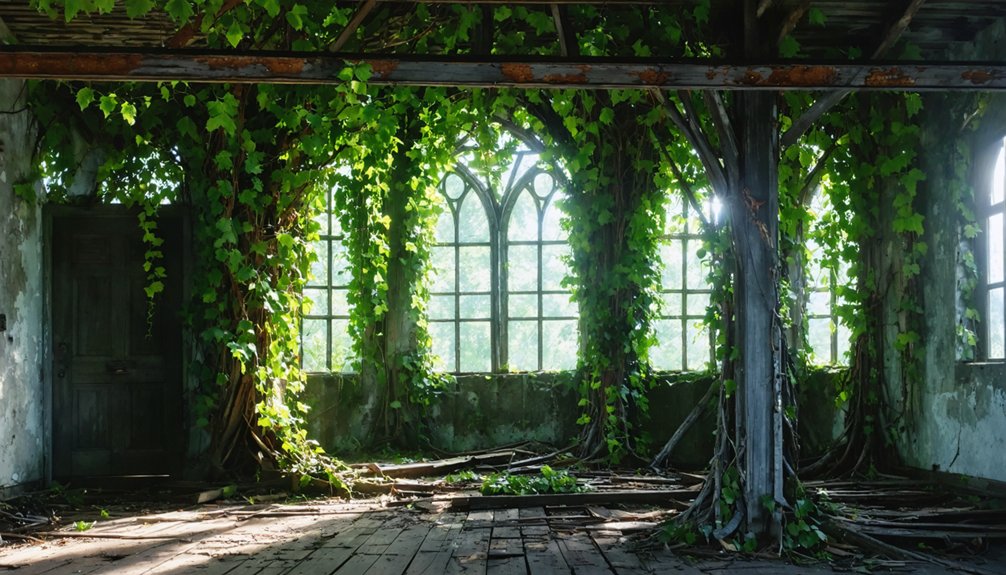
Nature’s patient dominance over Battelle’s remnants stands as a tribute to time’s transformative power.
Through ecological succession, dense forest has reclaimed every inch of this once-bustling industrial town. You’ll find only scattered handmade bricks and rotted lumber where buildings once stood, while aggressive vines consume what’s left of roofless structures.
Time and nature conspire to erase human ambition, as untamed forest devours the skeletal remains of industry’s past glory.
The site demonstrates three stark realities of abandonment:
- Industrial remnants like furnaces and coke ovens have virtually disappeared
- Former streets and public spaces are now indistinguishable from the forest floor
- Only non-native flowers and stray bricks hint at human presence
The area’s transformation proves nature’s resilience – even the water system, once pumping from a spring into wooden tanks, has vanished beneath a century of untamed growth.
Haunting Tales and Local Legends
Deep within DeKalb County’s forgotten corners, Battelle’s ruins harbor darker stories alongside their industrial decline.
You’ll hear tales of ghost sightings near the old furnace, where Drew Hester met his fate in 1906 beneath molten slag. Unexplained screams and mysterious clangs echo through the crumbling industrial remains, while spectral encounters are frequently reported around the coke ovens and railroad tracks.
The area’s haunting reputation draws from its tragic past, including mining accidents, murders, and the influence of local folklore figure Granny Dollar, whose Cherokee heritage adds depth to the supernatural landscape.
While some attribute the eerie sounds to natural causes, countless witnesses maintain that restless spirits of former residents and workers still wander these overgrown grounds, refusing to abandon their former home.
Archaeological Remnants
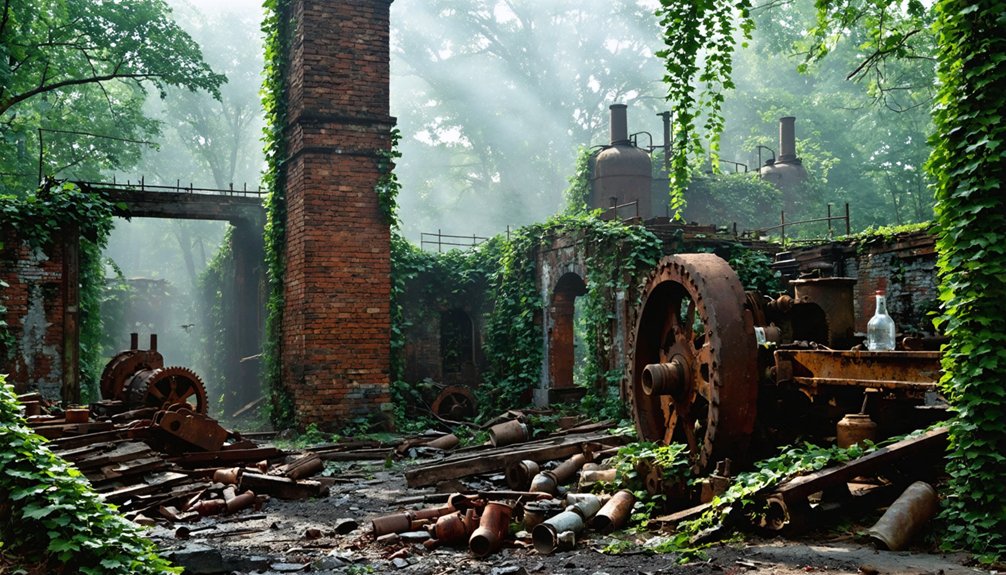
The scattered remains of Battelle’s industrial past lie buried beneath decades of forest growth in DeKalb County. Through careful artifact analysis, you’ll discover traces of this once-thriving mining community, where beehive coke ovens and scattered bricks reveal its archaeological significance.
Today’s untamed forest conceals the foundations of what was once a bustling town with hundreds of homes, a school, and industrial facilities.
You can still find evidence of the community’s resilient spirit:
- Persistent domestic rose bushes and jonquils mark former residential gardens
- Remnants of the advanced water system, including spring-fed pipes
- Industrial artifacts like metal scraps and tongue-and-groove lumber fragments
These surviving elements tell the story of Battelle’s brief but impactful existence, waiting for future archaeological exploration to uncover more secrets.
Preserving Battelle’s Legacy
While ghost towns across Alabama face preservation challenges, dedicated community efforts have emerged to protect Battelle’s historical legacy.
You’ll find local historians and descendants working together through community engagement initiatives, organizing tours and preservation awareness events to keep the town’s memory alive.
Funding strategies for Battelle’s preservation have shifted from government support to private fundraising campaigns and foundation partnerships.
You can participate in ghost tours and historical documentation efforts that help generate resources for maintaining the site’s remaining structures and artifacts.
Community organizations are actively working to secure and preserve key parcels of the original township, fighting against natural reclamation and forest overgrowth.
Through these combined efforts, you’re witnessing the protection of an important piece of Alabama’s industrial heritage for future generations.
Frequently Asked Questions
Are There Any Surviving Maps Showing the Original Layout of Battelle?
You won’t find surviving maps showing Battelle’s original layout, though historical significance can be traced through photographs, local historians’ accounts, and physical remnants scattered at the mountain’s base.
What Happened to the Residents After the Town Was Abandoned?
You’ll find resident stories showing they scattered to Birmingham and other industrial centers, seeking work after 1905. Some maintained their town legacy through oral histories and preserved photographs.
Were Any Movies or Documentaries Ever Filmed at Battelle?
You won’t find any film adaptations or historical reenactments documented at the site. While the ghost town’s haunting ruins could make compelling footage, safety concerns and private property restrictions prevent filming access.
Can Metal Detecting or Artifact Collecting Be Done Legally at Battelle?
You can’t legally metal detect or collect artifacts there since it’s private property. Current regulations require landowner permission, and the site’s industrial heritage requires special artifact preservation permits.
Are There Any Surviving Photographs of Daily Life in Battelle?
You’ll find surviving photos preserved mainly by Robert N. Mann, showing the town’s historical significance through images of homes, furnaces, and daily life that shaped local folklore and mining culture.
References
- https://visitlookoutmountain.com/a-haunted-history-of-lookout-mountain-and-fort-payne/
- https://digitalalabama.com/alabama-ghost-towns/alabama-ghost-towns/9449
- https://www.landmarksdekalbal.org/the-ruins-of-battelle/
- https://digitalalabama.com/article/alabama-ghost-towns/page/3
- https://www.ghostlyworld.org/places/battelle-alabama/
- https://en.wikipedia.org/wiki/Battelle
- https://www.battelle.org/history/milestones
- https://www.hmdb.org/m.asp?m=61018
- https://www.mininghistoryassociation.org/Birmingham2022.htm
- https://www.alabamahistory.net/copy-of-dallas
